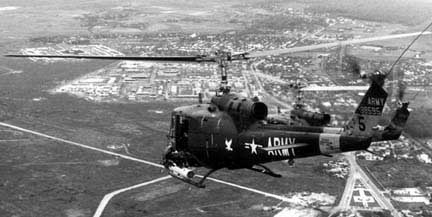.gif) |
|
|
a. 33d Transportation Company (Lt Hel) changed to 118th Aviation Company (Air Mbl Lt)...." |
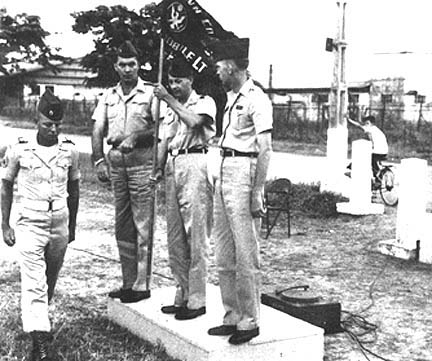
| Jack Phillabaum, Operations Officer of the 33rd/118th recalls: "Because the H-21 helicopter wasn't the most trustworthy aircraft in the world, all H-21 missions(except maybe "milk runs" into TSN) were flown with two ships, even if one would do. this put an excessive amount of time on these complex aircraft and resulted in considerable numbers being down for maintenance. When the 118th became operational with the UH-1B on 16 Sep, 1963, we continued flying two ship missions, briefly. But, shortly after this, I asked permission to go to single ship missions and it was approved!" |
| Alan Laya, CH-21 pilot and HU-1 pilot during the change over remembers: "The HU-1's finally began to arrive but not before we were involved in one more combat assault north of Phan Thiet. With B-26's, T-28's and Armed Huey's(UTT), the mission was a success. The landing zone was beyond belief; an area large enough for a single ship, but rough enough to never want to see it again. We had four LZ's and flew in flights of four so each approached his respective LZ at the same time. I had to drop the aircraft over a tree line then try and bring it to a hover because of the mounds and tree stumps. With ten troops on board, I couldn't salvage the landing and had to bring it to the ground. Fortunately, we hit solid ground with no forward roll, but on the next lift into the area, we were not as fortunate. I landed on a mound knocking the big beast(H-21) to one side. She started to tip on the left side but we did have enough power to straighten her and bounce her in again this time level. In leaving the area the trees in front of us presented quite an obstacle. I can still feel that front wheel clipping the tree tops as we pumped the collective trying to retain power to get airspeed and then altitude. Another day, another combat assault, a few more gray hairs and another trying day for the nervous system. That day will always be memorable because it was the last time I flew an H-21! We had our HU-1's waiting for us in Saigon." |
| Jack Phillabaum, Operations Officer of the 33rd/118th remembers; " The first UH-1B operational mission was actually flown on 15 Sep 1963. A mission request came in asking us to fly to Tay Ninh to pick-up an injured civilian, at night. I requested permission and permission was given,(from who I don't remember) to use the UH-1B instead of the H-21. With Lt. Chad Payne in one aircraft and me in another, we received a radar vector from Tan Son Nhut while an Air Force A-20 flew overhead cover, and we completed this first UH-1B mission for the 118th." |
|
|
| Wayne Wright, a 63-64 "Thunderbird" remembers: " We received either 24 or 25 brand new UH-1B's to replace the CH-21's. All the aircraft were in tail number sequence. I believe the last tail number was 22063 or 22064 with the last one being the maintenance ship. The first 8 were 1st PLT, with red tails, second 8 were 2nd PLT, with blue tails and the last 8 were 3rd PLT Bandits, with yellow tails. Seems to me the last one (maintenance) had three narrow stripes of all three colors. Don't remember exactly when we got the UH-1B's but it must have been October 1963. We were transitioned by a training team right at Bien Hoa Air Base and my flight records show I began transition training into the "Huey" on Sep 18, 1963. " |
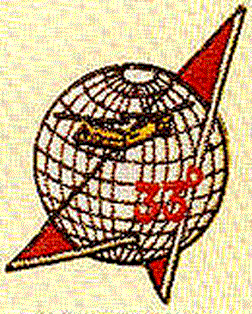 |
|
.gif) |
|
"Major Dave Hayes was a very proud Armor officer. He wanted a unit symbol that was befitting an assault aviation company. The 33rd Transportation patch was not especially to his liking. Dave Hayes did not think that the 118th Aviation Company was in the transportation business, only. He was a warrior and he wanted something in keeping with the warrior spirit. And, he wanted a unit patch that carried warrior symbols and portrayed a warrior message! Remember, in 1963, the War had not really started. There was no Long Bien bureaucracy. So, Major Hayes could do about whatever he wanted! " " Major Hayes wanted the colors
of the three Combat Arms (Red, Yellow and Light Blue and Army
Aviation-Teal Blue) on the unit patch design. He told me to develop
the idea. So, I had my wife send me a picture of the 416th Signal
Aviation Company patch that I had helped design several years
earlier. (See patch above) I had been an Aviator from 1960 until
1962 in the 416th Signal Aviation Company based at Fort Huachuca,
AZ. The Disney Studios had designed that original patch for the
416th. From World War II, the Disney Studios had designed many
patches for military units that requested their help as a patriotic
service...free of charge." "I showed my idea to Major Hayes. He loved it...although he wanted Armor Yellow as the background color instead of the teal blue we all know. I was able to convince him that the predominant color should be that of Army Aviation. He reluctantly agreed and directed that we develop a prototype!" " 'Cheap Charlies' tailor shop on Tu Do street in Saigon made the original rendition of the 118th patch. Major Hayes made the final color selection. He loved the diving Eagle with the Thunderbolt. The yellow color he selected in honor of his Armor heritage! To this day I believe he wanted yellow as the background color." "I believe we were the first Army Aviation unit to put a logo on the front of a Huey that was not a unit designator. The Eagle looked so good and later made its way to the battery compartment, also. " "Major Hayes also had each platoon's aircraft tail rotor pylons painted yellow, red and blue (Infantry blue was not possible because I believe Captain Jim Hughes or Captain Frank Radspinner, the 573 Transportation Detachment Commanders could not get the color right so Teal Blue went on the tail rotor pylons.) Now you know how the platoons came about having the color stripes on the tail fins!" "Jim Hughes and Frank Radspinner were very professional and experienced maintenance officers and Major Hayes was used to dealing with armored vehicle readiness rates and not Helicopter readiness rates. He drove those two esteemed gentlemen-- who were also very good guys--- nuts, when they told him all aircraft were not 100% ready. Accordingly, he blamed them for the non-Infantry dark blue paint." "The notch in the upper left of the "shield" came about after the third try by Disney. First was a circle which seemed boring because every fighter squadron in WWII had a circle patch. Second try was a diamond but the eagle was cramped and I wanted the eagle. The third try was the "notched" shape shield, which was very distinctive. I don't know where they got it."
|

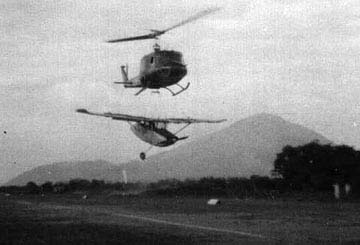
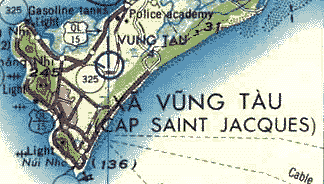
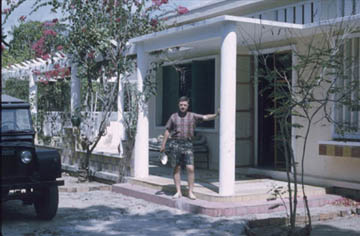
| Ted Jambon, tells the following story about one of his in country R & R's in Vung Tau......"When I was first in country, it was standard entertainment when we landed in Vung Tau and had to get to town we had to hire two horse drawn carts to take us. The deal was that the one who got there first would get the money for both carts. The drivers loved it and it would result in a wild race. Unfortunately, in one such race one of the horses died from over-exertion and the G.I.'s were ordered to pay up for the dead horse. That put the squelch on racing for a while. Then we switched to Lambrettas and cyclo racing." |
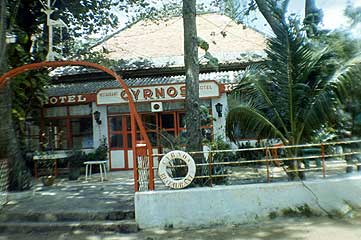 |
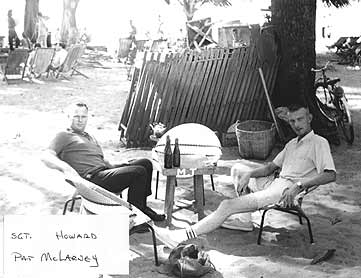 |
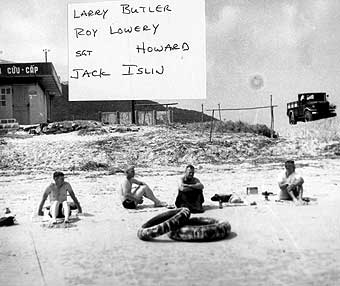 |
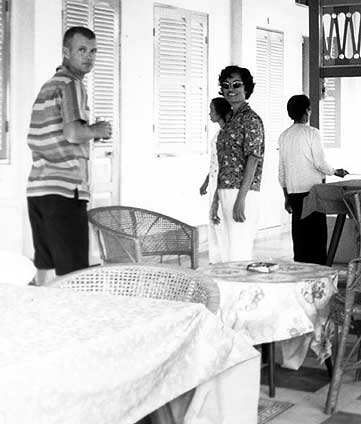 |
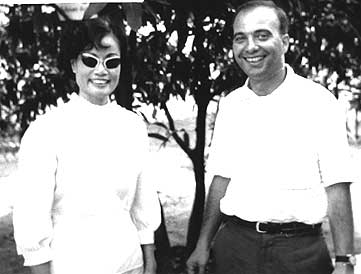 |
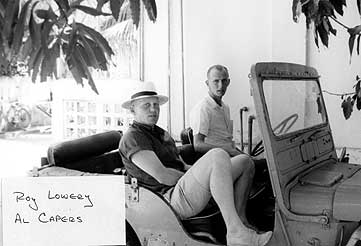 Roy
Lowery and Al Capers in "acquired" Roy
Lowery and Al Capers in "acquired" |
|
|
|
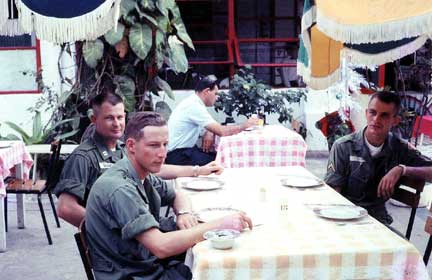 |
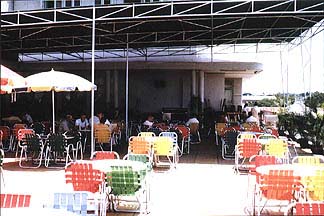
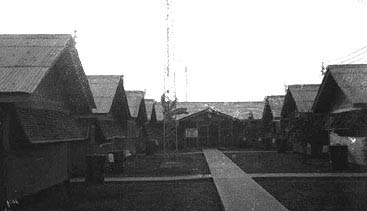
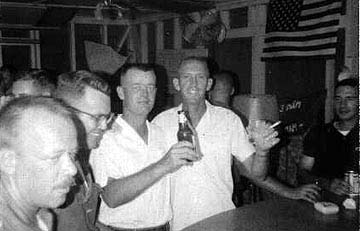
|
|
|
|
|
|
|
|
|
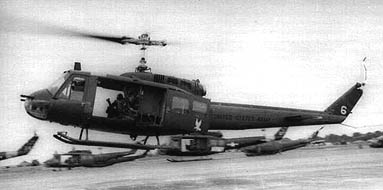
|
"I became the Crew chief on
the replacement "B" model for Blue Thunder 1 that was
lost at Dong Xoai. It was designated Blue Tail 9, because they
thought Blue 1 was a jinx. After a couple of days, when I had
the cosmoline cleaned off head and tail rotors, Bob Rux, crew
chief on Blue Tail 7, wanted my ship because it was the oddball.
I didn't care as long as I had my own ship, so we traded. |
